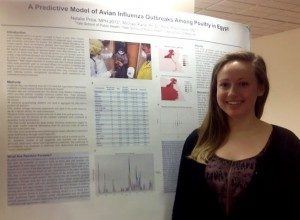Natalie Price, based in Mumbai, manages Vera’s Implementation Support Team. She has an MPH from Yale School of Public Health and brings more than five years of experience in the education, health, and technology sectors to the Vera team. This post is the latest in an ongoing series highlighting our team’s respective paths to Vera.

A veterinarian in Egypt reports a flock of sick chickens and sparks an investigation into a possible Avian flu outbreak. A community health worker in Honduras tracks the height and weight of her village’s children to identify and prevent malnutrition over time. A doctor at Princess Marina Hospital in Botswana examines her patient’s CD4 test results and is assured that her patient’s HIV medications are working. When it comes to public health, data saves lives.
But what if the veterinarian is unaware of the outbreak that’s been raging for weeks in the governorate next door? What if the scale used to weigh the children loses its calibration after being carried from village to village? What if the understaffed laboratory neglects to enter test results that show the severe side effects of the patient’s current medications? When it comes to public health, good data saves lives.
Technology has rapidly increased our ability to collect and share data. It’s fantastic to see a culture of data in the public health field emerge and take hold. Around the world, health information is used to treat and care for patients, to mobilize precious resources to local health systems, and to evaluate new treatments and prevention programs. More and more, we are seeing people demand effectiveness and accountability from healthcare providers, organizations, and governments, and data is the way to do that. We are demanding greater transparency in data to better understand the health of our communities, all while maintaining security and individuals’ privacy. But, we are only half way there. There is still too much health information that is not timely enough, not complete enough, and not accurate enough; the lack of timely, accurate, and complete data can be devastating.
Before coming to Vera I received my MPH from the Yale School of Public Health, where I worked with data from the UN Food and Agriculture Organization (FAO) and witnessed how powerful an international network of veterinarians, doctors, and public health officials can be. Their EMPRES-i disease surveillance system allows researchers and health workers around the world to use disease outbreak data in near real time. Timely data means that government officials, health workers, and organizations can respond to outbreaks in their earliest phases, which may determine their severity. When data comes in weeks or months later, the damage may already be done. In that time Avian flu outbreaks can take hold and gain momentum, humans can fall ill, and poultry farmers may experience irreparable damage to their livelihoods.
In graduate school I also travelled to Honduras and met with community health workers to help them develop a strategy to better monitor their programs. One of their programs involved monthly weigh-ins of the community’s children to track malnutrition. The health workers were concerned that they couldn’t properly identify children for intensive follow-up, because of inconsistent measurement tools and lack of training for volunteers. The scales were often hung from the rafters in various homes, making them difficult to calibrate after being moved around month after month. Volunteers had not been properly trained on how to consistently measure the height of infants, which sometimes led them to forgo collecting height data altogether. Having reliable, accurate tools and proper training to use those tools is necessary to collecting accurate data. Without accurate data, we may be seeing health problems that don’t exist, and missing the ones that do.
After graduating, I worked at Harvard School of Public Health in the Harvard AIDS Initiative. Our team in Boston and Botswana was tasked with evaluating the Botswana National HIV Treatment Program. This program provides antiretroviral drugs to all medically eligible citizens free of charge. In 2002, this nationwide program was one of the first of its kind, and the data coming in over the past decade indicates that the program has been successfully lengthening the lives of people living with HIV in Botswana. But, the data is not perfect. Tracking 200,000 individuals at clinics across a sparsely populated country is incredibly difficult. Lack of physical and human resources prevents data from being entered correctly or at all, and prevents data from travelling from hundreds of clinics to the centralized database in the capital. Incomplete data can leave health workers and public health researchers in the dark, unsure how their decisions to treat patients, enact legislation, or implement prevention programs have made an impact.
By the time I learned about Vera, I had worked with many organizations plagued by inaccurate, incomplete, and untimely data, and was tired of having to tell people “we can’t answer your important questions, and may never be able to with what data has been collected.” Without good data we aren’t making the best decisions and aren’t distributing our precious resources to those who can do the most good. I came to work at Vera because I want to contribute to the burgeoning culture of data that would ensure that everyone has access to the information they need to make informed decisions, whatever they may be – how to best treat patients, where to distribute medications in rural health districts, which NGO to donate money to. Most importantly, I want to help our clients, who are doing amazing work improving the health of their communities, maximize their impact.



